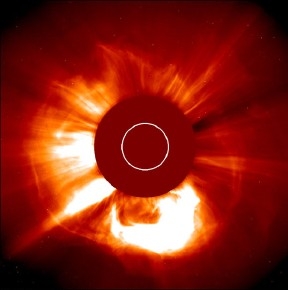
If your cell phone stopped working the other day, here is why:
A massive solar flare erupted from the surface of the Sun at 9:51 UTC on October 28, 2003. The solar flare persisted for more than an hour, peaking at 11:10 UTC. Associated with the flare was an ejection of a billion tons or more of gas from the Sun’s tenuous outer atmosphere, or corona. Both flare and coronal mass ejection accelerated charged particles to very high energies and hurled them at near the speed of light directly toward the Earth. It takes light roughly 8 minutes to travel from Sun to Earth and these particles made the trip in less than an hour.
… To put this event in perspective, NOAA predicts the impacts of the coronal mass ejection on the Earth’s magnetosphere will be a “4” (severe) on a scale of 1 to 5. The flare is the third largest ever recorded in the 30 years since NOAA began observing soft X-ray emissions from the Sun. Today’s flare is listed as an X17.2, with an X20 being the most intense flare ever observed in that time. People living in Quebec, Canada, may recall that in March 1989 an X15 solar storm was strong enough to knock out the region’s power grid.
And don’t miss the amazing animation of the solar flare as it happened!
